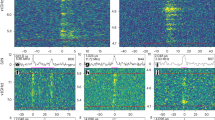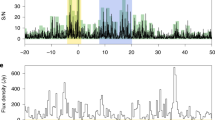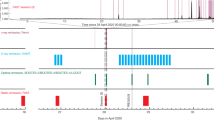Abstract
The field of fast radio burst (FRB) science is currently thriving. The lines of active investigation include theoretical and observational aspects of these enigmatic millisecond radio signals. These pursuits are for the most part intertwined so that each keeps the other in check, characteristic of the healthy state of the field. The immediate future for FRB science is full of promise—we will in the next few years see two orders of magnitude more FRBs discovered by the now diverse group of instruments spread across the globe involved in these efforts. This increased crop, and the increased information obtained per event, will allow a number of fundamental questions to be answered, and FRBs’ potential as astrophysical and cosmological tools to be exploited. Questions as to the exact detailed nature of FRB progenitors and whether or not there are one or more types of progenitor will be answered. Questions as to source counts, the luminosity distribution and cosmological density of FRBs will also be addressed. Looking further ahead, applications involving FRBs at the highest redshifts look set to be a major focus of the field. The potential exists to evolve to a point where statistically robust cosmological tests, orthogonal to those already undertaken in other ways, will be achieved. Related work into FRB foregrounds, as well as how to identify new events in ever more challenging radio-frequency interference environments, also appear likely avenues for extensive investigations in the coming years.
This is a preview of subscription content, access via your institution
Access options
Access Nature and 54 other Nature Portfolio journals
Get Nature+, our best-value online-access subscription
$29.99 / 30 days
cancel any time
Subscribe to this journal
Receive 12 digital issues and online access to articles
$119.00 per year
only $9.92 per issue
Buy this article
- Purchase on Springer Link
- Instant access to full article PDF
Prices may be subject to local taxes which are calculated during checkout



Similar content being viewed by others
References
Caleb, M., Spitler, L. G. & Stappers, B. W. One or several populations of fast radio burst sources? Nat. Astron. https://doi.org/10.1038/s41550-018-0612-z (2018).
Pen, U.-L. The nature of fast radio bursts. Nat. Astron. https://doi.org/10.1038/s41550-018-0620-z (2018).
Cordes, J. M. & Lazio, T. J. W. NE2001.I. A new model for the galactic distribution of free electrons and its fluctuations. Preprint at https://arxiv.org/abs/astro-ph/0207156 (2002).
Yao, J. M., Manchester, R. N. & Wang, N. A new electron-density model for estimation of pulsar and FRB distances. Astrophys. J. 835, 29 (2016).
Bhandari, S. et al. The SUrvey for Pulsars and Extragalactic Radio Bursts-II. New FRB discoveries and their follow-up. Mon. Not. R. Astron. Soc. 475, 1427–1446 (2018).
Inoue, S. Probing the cosmic reionization history and local environment of gamma-ray bursts through radio dispersion. Mon. Not. R. Astron. Soc. 348, 999–1008 (2004).
Xu, J. & Han, J. L. Extragalactic dispersion measures of fast radio bursts. Res. Astron. Astrophys. 15, 1629 (2015).
Macquart, J.-P. et al. Fast transients at cosmological distances with the SKA. Advancing Astrophysics with the Square Kilometre Array (AASKA14) 55 (2015).
Macquart, J.-P. & Ekers, R. D. FRB event rate counts II fluence, redshift and dispersion measure distributions. Mon. Not. R. Astron. Soc 480, 4211–4230 (2018).
Hankins, T. H., Eilek, J. A. & Jones, G. The Crab pulsar at centimeter wavelengths. II. single pulses. Astrophys. J. 833, 47 (2016).
Farah, W. et al. FRB microstructure revealed by the real-time detection of FRB170827. Mon. Not. R. Astron. Soc. 478, 1209–1217 (2018).
Lorimer, D. R., Bailes, M., McLaughlin, M. A., Narkevic, D. J. & Crawford, F. A bright millisecond radio burst of extragalactic origin. Science 318, 777–780 (2007).
Burke-Spolaor, S., Bailes, M., Ekers, R., Macquart, J.-P. & Crawford, F. Radio bursts with extragalactic spectral characteristics show terrestrial origins. Astrophys. J. 727, 18 (2011).
Keane, E. F., Stappers, B. W., Kramer, M. & Lyne, A. G. On the origin of a highly dispersed coherent radio burst. Mon. Not. R. Astron. Soc. 425, L71–L75 (2012).
Thornton, D. et al. A population of fast radio bursts at cosmological distances. Science 341, 53–56 (2013).
Spitler, L. G. et al. Fast radio burst discovered in the Arecibo Pulsar ALFA Survey. Astrophys. J. 790, 101–110 (2014).
Petroff, E. et al. Identifying the source of perytons at the Parkes radio telescope. Mon. Not. R. Astron. Soc. 451, 3933–3940 (2015).
Caleb, M. et al. The first interferometric detections of fast radio bursts. Mon. Not. R. Astron. Soc. 468, 3746–3756 (2017).
Macquart, J.-P. Probing the Universe’s baryons with fast radio bursts. Nat. Astron. https://doi.org/10.1038/s41550-018-0625-7 (2018).
Bregman, J. N. The search for the missing baryons at low redshift. Ann. Rev. Astron. Astrophys. 45, 221–259 (2007).
Shull, J. M., Smith, B. D. & Danforth, C. W. The baryon census in a multiphase intergalactic medium: 30% of the baryons may still be missing. Astrophys. J. 759, 23 (2012).
Hinshaw, G. et al. Nine-year Wilkinson Microwave Anisotropy Probe (WMAP) Observations: cosmological parameter results. Astrophys. J. Supp. 208, 19 (2013).
McQuinn, M. Locating the “missing” baryons with extragalactic dispersion measure estimates. Astrophys. J. 780, L33–L38 (2014).
Masui, K. et al. Dense magnetized plasma associated with a fast radio burst. Nature 528, 523–525 (2015).
Michili, D. et al. An extreme magneto-ionic environment associated with the fast radio burst source FRB 121102. Nature 553, 182–185 (2018).
Caleb, M. et al. The SUrvey for Pulsars and Extragalactic Radio Bursts-III. Polarization properties of FRBs 160102 and 151230. Mon. Not. R. Astron. Soc. 478, 2046–2055 (2018).
Ravi, V. et al. The magnetic field and turbulence of the cosmic web measured using a brilliant fast radio burst. Science 354, 1249–1252 (2016).
Macquart, J.-P. & Koay, Y. Temporal smearing of transient radio sources by the intergalactic medium. Astrophys. J. 776, 125 (2013).
Keane, E. F., Kramer, M., Lyne, A. G., Stappers, B. W. & McLaughlin, M. A. Rotating Radio Transients: new discoveries, timing solutions and musings. Mon. Not. R. Astron. Soc. 415, 3065–3080 (2011).
Burke-Spolaor, S. & Bannister, K. W. The galactic position dependence of fast radio bursts and the discovery of FRB 011025. Astrophys. J. 792, 19–26 (2014).
Manchester, R. N. et al. The Parkes multi-beam pulsar survey-I. Observing and data analysis systems, discovery and timing of 100 pulsars. Mon. Not. R. Astron. Soc. 328, 17–35 (2001).
Burgay, M. et al. The Parkes high-latitude pulsar survey. Mon. Not. R. Astron. Soc. 368, 283–292 (2006).
Jacoby, B. A., Bailes, M., Ord, S. M., Edwards, R. T. & Kulkarni, S. R. A Large-Area Survey for Radio Pulsars at High Galactic Latitudes. Astrophys. J. 699, 2009–2016 (2009).
Burgay, M. et al. The Perseus Arm Pulsar Survey. Mon. Not. R. Astron. Soc. 429, 579–588 (2013).
Keith, M. J. et al. The High Time Resolution Universe Pulsar Survey-I. System configuration and initial discoveries. Mon. Not. R. Astron. Soc. 409, 619–627 (2010).
Barr, E. D. et al. The Northern High Time Resolution Universe Pulsar Survey-I. Setup and initial discoveries. Mon. Not. R. Astron. Soc. 435, 2234–2245 (2013).
Champion, D. et al. Five new Fast Radio Bursts from the HTRU high latitude survey: first evidence for two-component bursts. Mon. Not. R. Astron. Soc. 460, L30–L34 (2015).
Spitler, L. G. et al. A repeating fast radio burst. Nature 531, 202–205 (2016).
Hardy, L. K. et al. A search for optical bursts from the repeating fast radio burst FRB 121102. Mon. Not. R. Astron. Soc. 472, 2800–2807 (2017).
Acero, F. et al. French SKA White Book-The French community towards the Square Kilometre Array. Preprint at https://arxiv.org/abs/1712.06950 (2017).
Scholz, P. et al. Simultaneous X-ray, gamma-ray, and radio observations of the repeating fast radio burst FRB 121102. Astrophys. J. 846, 80 (2017).
Oppermann, N., Yu, H.-R. & Pen, U.-L. On the non-Poissonian repetition pattern of FRB121102. Mon. Not. R. Astron. Soc. 475, 5109–5115 (2018).
Chatterjee, S. et al. A direct localization of a fast radio burst and its host. Nature 541, 58–61 (2017).
Tendulkar, S. P. et al. The host galaxy and redshift of the repeating fast radio burst FRB 121102. Astrophys. J. 834, L7 (2017).
Bassa, C. G. et al. FRB 121102 is coincident with a star-forming region in its host galaxy. Astrophys. J. 843, L8 (2017).
Keane, E. F. The Transient Radio Sky. PhD thesis, Univ. Manchester (2010)
Katz, J. I. Excess close burst pairs in FRB 121102. Mon. Not. R. Astron. Soc. 476, 1849–1852 (2018).
Beloborodov, A. M. A flaring magnetar in FRB 121102? Astrophys. J. 843, L26 (2017).
Patel, C. et al. PALFA single-pulse pipeline: New pulsars, rotating radio transients and a candidate fast radio burst. Preprint at https://arxiv.org/abs/1808.03710 (2018).
Bailes, M. et al. The UTMOST: A hybrid digital signal processor transforms the Molonglo Observatory Synthesis Telescope. Publ. Astron. Soc. Aus. 34, 45 (2017).
Chawla, P. et al. A search for fast radio bursts with the GBNCC Pulsar Survey. Astrophys. J. 844, 140 (2017).
Bannister, K. W. et al. The detection of an extremely bright fast radio burst in a phased array feed survey. Astrophys. J. 841, L12 (2017).
Shannon, R. M. et al. The dispersion–brightness relation for fast radio bursts from a wide-field survey. Nature https://doi.org/10.1038/s41586-018-0588-y (2018).
Boyle, P. J. et al. First detection of fast radio bursts between 400 and 800 MHz by CHIME/FRB. Astronomer’s Telegram 11901 (2018).
Falcke, H. & Rezzolla, L. Fast radio bursts: the last sign of supramassive neutron stars. Astron. Astrophys. 562, 137 (2014).
Staveley-Smith, L. et al. The Parkes 21 cm multibeam receiver. Publ. Astron. Soc. Aus. 13, 243–248 (1996).
Price, D. C. et al. HIPSR: A digital signal processor for the Parkes 21-cm Multibeam Receiver. J. Astron. Instrum. 5, 1641007 (2016).
Macquart, J.-P. & Ekers, R. D. Fast radio burst event rate counts-I. Interpreting the observations. Mon. Not. R. Astron. Soc. 474, 1900–1908 (2018).
Keane, E. F. et al. The SUrvey for Pulsars and Extragalactic Radio Bursts-I. Survey description and overview. Mon. Not. R. Astron. Soc. 473, 116–135 (2018).
Bhandari, S. et al. Discovery of FRB 180923 at the Parkes Radio Telescope Astronomer's Telegram 12060 (2018).
Keane, E. F. & Petroff, E. Fast radio bursts: search sensitivities and completeness. Mon. Not. R. Astron. Soc. 447, 2852–2856 (2015).
Ryle, M. & Clarke, R. W. An examination of the steady-state model in the light of some recent observations of radio sources. Mon. Not. R. Astron. Soc. 122, 349 (1961).
Vedantham, H., Ravi, V., Hallinan, G. & Shannon, R. M. The fluence and distance distributions of fast radio bursts. Astrophys. J. 830, 75 (2016).
Keane, E. F. et al. The host galaxy of a fast radio burst. Nature 530, 453–456 (2016).
Gajjar, V. et al. Highest-frequency detection of FRB 121102 at 4-8 GHz using the Breakthrough Listen digital backend at the Green Bank Telescope. Astrophys. J. https://doi.org/10.3847/1538-4357/aad005 (2018).
Keane, E. F. Classifying RRATs and FRBs. Mon. Not. R. Astron. Soc. 459, 1360–1362 (2016).
Rane, A. & Loeb, A. A search for host galaxies of potentially extragalactic rotating radio transients. Mon. Not. R. Astron. Soc. 467, L11–L15 (2017).
Petroff, E. et al. A real-time fast radio burst: polarization detection and multiwavelength follow-up. Mon. Not. R. Astron. Soc. 447, 246–255 (2015).
Petroff, E. et al. A polarized fast radio burst at low Galactic latitude. Mon. Not. R. Astron. Soc. 469, 4465–4482 (2017).
Connor, L., Sievers, J. & Pen, U.-L. Non-cosmological FRBs from young supernova remnant pulsars. Mon. Not. R. Astron. Soc. 458, L19–L23 (2015).
Price, D. C. et al. Detection of a new fast radio burst during Breakthrough Listen observations. Astronomer’s Telegram 11376 (2018).
Oslowski, S. et al. Real-time detection of an extremely high signal-to-noise ratio fast radio burst during observations of PSR J2124-3358. Astronomer’s Telegram 11385 (2018).
Oslowski, S. et al. A second fast radio burst discovered with Parkes Telescope within 50 hours: FRB180311 in the direction of PSR J2129-5721. Astronomer’s Telegram 11396 (2018).
Oslowski, S. et al. A fast radio burst towards the millisecond pulsar PSR J1744-1134 found during a commensal search by the Parkes Pulsar Timing Array. Astronomer’s Telegram 11851 (2018).
Fialkov, A., Loeb, A. & Lorimer, D. R. Enhanced rates of fast radio bursts from galaxy clusters. Preprint at https://arxiv.org/abs/1711.04396 (2018).
Ioka, K. The cosmic dispersion measure from gamma-ray burst afterglows: Probing the reionization history and the burst environment. Astrophys. J. 598, L79–L82 (2003).
Sokasian, A., Abel, T. & Hernquist, L. The epoch of helium reionization. Mon. Not. R. Astron. Soc. 332, 601–616 (2002).
Zhou, B., Li, X., Wang, T., Fan, Y.-Z. & Wei, D.-M. Fast radio bursts as a cosmic probe? Phys. Rev. D 89, 107303 (2014).
Petroff, E. et al. FRBCAT: The Fast Radio Burst Catalogue. Publ. Astron. Soc. Aus. 33, e045 (2016).
Lorimer, D. R. A decade of fast radio bursts. Nat. Astron. https://doi.org/10.1038/s41550-018-0607-9 (2018).
Dolag, K., Gaensler, B. M., Beck, A. M. & Beck, M. C. Constraints on the distribution and energetics of fast radio bursts using cosmological hydrodynamic simulations. Mon. Not. R. Astron. Soc. 451, 4277–4289 (2015).
Zheng, Z., Ofek, E. O., Kulkarni, S. R., Neill, J. D. & Juric, M. Probing the intergalactic medium with fast radio bursts. Astrophys. J. 797, 71 (2014).
Madau, P. & Dickinson, M. Cosmic star-formation history. Ann. Rev. Astron. Astrophys. 52, 415–486 (2014).
Amiri, M. et al. The CHIME Fast Radio Burst Project: System overview. Astrophys. J. https://doi.org/10.3847/1538-4357/aad188 (2014).
Stappers, B. W. MeerTRAP: Real time commensal searching for transients and pulsars with MeerKAT. Proc. Sci. (MeerKAT2016) 10 (2016); https://pos.sissa.it/277/010/pdf
Keane, E. F. & Green, J. Parkes Fast Radio Burst National Facility Detection Mode Parkes October 2018 Call for Proposals Discussion Document (2016); https://www.atnf.csiro.au/observers/apply/PARKES_FRB_mode_CallDraft.pdf
Li, D. et al. FAST in space: Considerations for a multibeam, multipurpose survey using China’s 500-m Aperture Spherical Radio Telescope (FAST). IEEE Microwave Magazine 19, 112–119 (2018).
Keane, E. F. Pulsar science with the SKA. IAU Symp. 337, 158–164 (2017).
Karastergiou, A. et al. Limits on fast radio bursts at 145 MHz with ARTEMIS, a real-time software backend. Mon. Not. R. Astron. Soc. 452, 1254–1262 (2015).
Green, J. Future plans for the Parkes Radio Telescope in the era of the SKA. Proc. URSI General Assembly http://www.ursi.org/proceedings/procGA17/papers/Paper_J23-2(2222).pdf (2017).
Rossi, D. A. et al. Performance of a highly sensitive, 19-element, dual-polarization, cryogenic L-band phased-array feed on the Green Bank Telescope. Astron. J. 155, 202 (2018).
Maan, Y. & van Leeuwen, J. Real-time searches for fast transients with Apertif and LOFAR. Preprint at https://arxiv.org/abs/1709.06104 (2017).
Fender, R. & Oosterloo, T. Neutral hydrogen absorption towards Fast Radio Bursts. Mon. Not. R. Astron. Soc. 451, L75–L79 (2015).
Pietka, M., Fender, R. P. & Keane, E. F. The variability time-scales and brightness temperatures of radio flares from stars to supermassive black holes. Mon. Not. R. Astron. Soc. 446, 3687–3696 (2015).
Barsdell, B. R., Bailes, M., Barnes, D. G. & Fluke, C. J. Accelerating incoherent dedispersion. Mon. Not. R. Astron. Soc. 422, 379–392 (2012).
Fukugita, M. & Peebles, P. J. E. The Cosmic Energy Inventory. Astrophys. J. 616, 643–668 (2004).
Acknowledgements
The author would like to thank D. Lorimer, M. Caleb, J. Green and the anonymous referee for helpful comments that improved the quality of this manuscript. The author would like to thank the ASKAP FRB team for providing advanced knowledge of their first 26 FRB discoveries, to the PALFA FRB team for advanced knowledge on FRB 141113, and to the DSA FRB team for advanced knowledge on the DSA specifications.
Author information
Authors and Affiliations
Corresponding author
Ethics declarations
Competing interests
The authors declare no competing interests.
Additional information
Publisher’s note: Springer Nature remains neutral with regard to jurisdictional claims in published maps and institutional affiliations.
Rights and permissions
About this article
Cite this article
Keane, E.F. The future of fast radio burst science. Nat Astron 2, 865–872 (2018). https://doi.org/10.1038/s41550-018-0603-0
Received:
Accepted:
Published:
Issue Date:
DOI: https://doi.org/10.1038/s41550-018-0603-0
This article is cited by
-
Burst timescales and luminosities as links between young pulsars and fast radio bursts
Nature Astronomy (2022)
-
THEZA: TeraHertz Exploration and Zooming-in for Astrophysics
Experimental Astronomy (2021)
-
A fast radio burst associated with a Galactic magnetar
Nature (2020)
-
A decade of fast radio bursts
Nature Astronomy (2018)



